Related Research Articles

Dessert is a course that concludes a meal. The course consists of sweet foods, such as cake, biscuit, ice cream and possibly a beverage such as dessert wine and liqueur. Some cultures sweeten foods that are more commonly savory to create desserts. In some parts of the world there is no tradition of a dessert course to conclude a meal.

Confectionery is the art of making confections, or sweet foods. Confections are items that are rich in sugar and carbohydrates although exact definitions are difficult. In general, however, confections are divided into two broad and somewhat overlapping categories: bakers' confections and sugar confections.
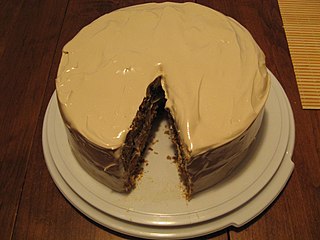
Spice cake is a type of cake that is traditionally flavored with a mixture of spices. The cake can be prepared in many varieties. Predominant flavorings include spices such as cinnamon, cloves, allspice, ginger, and nutmeg.

Eton mess is a traditional English dessert consisting of a mixture of strawberries or other berries, meringue, and whipped cream. First mentioned in print in 1893, it is commonly believed to originate from Eton College and is served at the annual cricket match against the pupils of Harrow School. Eton mess is occasionally served at Harrow School, where it is referred to as Harrow mess.

Barfi or burfi is a milk-based sweet from the Indian subcontinent with a fudge-like consistency. Its name comes from the Persian and Urdu word (barf) for snow. Barfi is consumed throughout India and Pakistan and is especially popular in North India. It is often served at celebrations and religious festivals such as Diwali and Holi.

Summer pudding or summer fruit pudding is an English dessert made of sliced white bread, layered in a deep bowl with fruit and fruit juice. It is left to soak overnight and turned out onto a plate. The dessert was most popular from the late 19th to the early 20th century. It first appears in print with its current name in 1904, but identical recipes for 'hydropathic pudding' and 'Malvern pudding' from as far back as 1868 have been found.

Dobos torte, also known as Dobosh, is a Hungarian sponge cake layered with chocolate buttercream and topped with caramel. The layered pastry is named after its inventor, Hungarian chef József C. Dobos, a delicatessen owner in Budapest. In the late 1800s, he decided to create a cake that would last longer than other pastries in an age when cooling techniques were limited. The round sides of the cake are coated with ground hazelnuts, chestnuts, walnuts, or almonds, and the hardened caramel top helps to prevent drying out, for a longer shelf life.

Flapper pie, or the forgotten Prairie pie, is a vanilla custard pie topped with meringue within a graham cracker crust.

A bombe glacée, or simply a bombe, is a French ice cream dessert frozen in a spherical mould so as to resemble a cannonball, hence the name ice cream bomb. Escoffier gives over sixty recipes for bombes in Le Guide culinaire. The dessert appeared on restaurant menus as early as 1882.
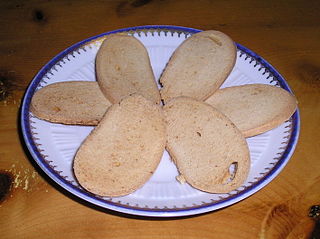
Baicoli are Italian biscuits, originating in the 1700s in the city of Venice. They are made with sugar, butter, flour, yeast, eggs, and salt.
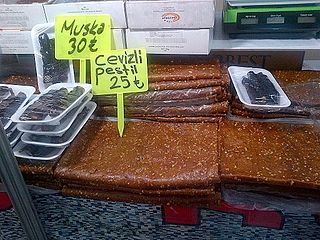
Pestil, also known as bastık or pastegh is dried fruit pulp, best exemplified in the English term "fruit leather." Fruit leather is made from mechanically pulverizing fruit, then spreading it out to dry into a tough, yet flexible and edible material which can be kept preserved for several months in an airtight container. It is a popular dessert in Armenia and Turkey.
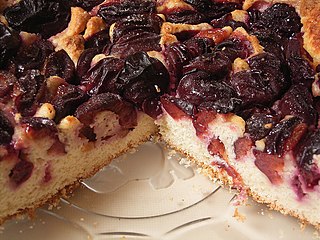
Plum cake refers to a wide range of cakes usually made with dried fruits such as currants, raisins, sultanas, or prunes, and also sometimes with fresh fruits. There is a wide range of popular plum cakes and puddings. Since the meaning of the word "plum" has changed over time, many items referred to as plum cakes and popular in England since at least the eighteenth century have now become known as fruitcake. The English variety of plum cake also exists on the European mainland, but may vary in ingredients and consistency. British colonists and missionaries brought the dried fruit variety of cake with them, for example, in British India where it was served around the time of the Christmas holiday season. In America's Thirteen Colonies, where it became associated with elections, one version came to be called election cake.
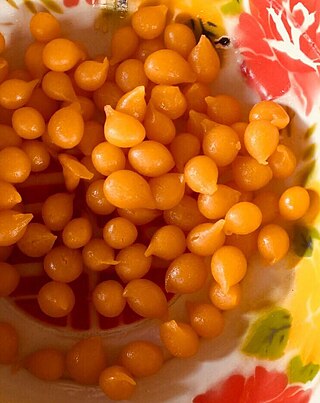
Thong yot, also known as "gold egg-yolks drops", is an ancient Thai dessert and one of the nine auspicious traditional Thai desserts. Thong yot originated in Aveiro District, Portugal. Thong yot was adapted from ovos moles de aveiro, a Portuguese dessert, by Maria Guyomar de Pinha, who was appointed as a cook in the palace in the period of King Narai of Ayutthaya. Thong yot is made from egg yolks, flour and sugar.
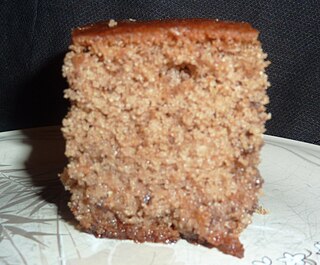
Karydopita is a Greek dessert cake made primarily from walnuts and covered in a sweet syrup. Its name is a compound word which derives from "karýdia" and "pita".

Darra Goldstein is an American author and food scholar who is the Willcox B. and Harriet M. Adsit Professor of Russian, emerita at Williams College.

Sherbet, often referred to as sherbert, is a frozen dessert made from water, sugar, a dairy product such as cream or milk, and a flavoring – typically fruit juice or purée, wine, liqueur, or occasionally non-fruit flavors such as vanilla, chocolate, or peppermint. It is similar to, but distinct from, sorbet, which lacks dairy.

Guryev porridge is a Russian sweet porridge (kasha) prepared from semolina and milk with the addition of candied nuts, honey and dried fruits.
Leach was a popular medieval sweetmeat (confection) consisting of a thick, jelly-like preserve which set hard enough to be sliced for serving.
Amygdalopita is an almond cake in Greek cuisine made with ground almonds, flour, butter, eggs and pastry cream. It is one of the most common glyka tapsiou - dessert dishes like pies and breads baked in baking pans. Other common desserts of this style are galaktoboureko, karydopita and kadaifi.

White cake is a type of cake that is made without egg yolks. White cakes were also once known as silver cakes.
References
- ↑ Hannele Klematillā, 'Sucket', Darra Goldstein, The Oxford Companion to Sugar and Sweets (Oxford, 2015), p. 662.
- ↑ Arthur Collins, Jewels and Plate of Elizabeth I (London, 1955), pp. 430 no. 814, 433 no. 832, 584 no. 1558, 591-2 no. 1581.
- ↑ Phillipa Glanville, 'Sucket fork', Darra Goldstein, The Oxford Companion to Sugar and Sweets (Oxford, 2015), p. 661.
- ↑ John Nichols's The Progresses and Public Processions of Queen Elizabeth, vol. 1 (Oxford, 2014), p. 244.
- ↑ British Library, Mary, Queen of Scots: two new acquisitions